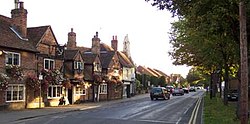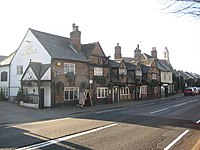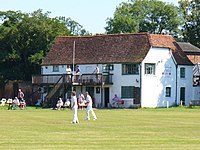Ripley, Surrey
| Ripley | |
| Surrey | |
|---|---|
 Ripley High Street | |
| Location | |
| Grid reference: | TQ055565 |
| Location: | 51°17’52"N, 0°29’17"W |
| Data | |
| Population: | 2,041 (2001) |
| Post town: | Woking |
| Postcode: | GU23 |
| Dialling code: | 01483 |
| Local Government | |
| Council: | Guildford |
| Parliamentary constituency: |
Mole Valley |
Ripley is a village in the midst of Surrey, stretched along the old Portmouth Road which ran between London and Portsmouth. The village grew up on that main road and prospered from it and the traffic which passed, the road, now become the A3 has in modern times become a virtual motorway and Ripley is now bypassed seamlessly by it, leaving Ripley to carry on as a peaceful and pretty village.
The village is close to the M25 motorway and 6½ southeast of Woking, 7 miles northeast of Guildford. Lanes lead off to Send, Send Marsh and Ockham, and to the thundering A3 and nearby M25.
The village includes a coaching inn, The Talbot Hotel which dates back to 1453.[1] There is also a specialist shoe manufacturer, Clifford James, as well as Drake's restaurant, which has been awarded a Michelin star and 3 AA rosettes.
Ripley is mentioned in H G Wells' novels The War of the Worlds and The Wheels of Chance.
Cricket has been a popular sport in the village for 200 years, played on the Green there.
Parish church

The village church is dedicated to St Mary Magdalen. It appears as a modern church, but within it has a fine Norman chancel.[2]
The first church here was built in the 12th Century, believed to be connected to the monks of Newark Priory nearby. It became not a parish church but a Chapel of Ease to serve the community which had grown up around the crossroads in Ripley. The Priory owned the church until it was dissolved at the Reformation. The church was demolished in the Victorian period and built anew in the village Gothic style, leaving only the old chancel standing: the old church had sufferd from damp and was too small for the village.
When cyclists started to pour into Ripley from the late nineteenth century, the vicar sent a message to the Anchor, where they congregated, asking if they would like to share in Evensong, and many were happy to do so. Cyclists made substantial donations for the installation the organ in the Church and subscribed to the erection of a stained glass window in the Church. The church also contains a brass memorial plaque to commemorate Herbert Liddell Cortis, the first person to do 30 miles an hour on a bicycle.
Cyclists

In the 1870s, cycling became a popular activity and cyclists congregated on Ripley. The village was a convenient distance from London, whether for a day out or on the road to Portsmouth and the south coast, and so that many cyclists would stop there for a break at the Anchor Inn. Sisters Annie and Harriet Dibble encouraged the cyclists so much that, in some years in the following decade, their visitors' book was signed with over 7,000 names - all arriving on penny-farthings or boneshakers.
The Anchor in the village contains mementoes of the great days of the cyclists. Those high days of the bicycle are gone, and the Portsmouth Road, at least in its guise of the A3, is no longer a friendly road for the cyclist.
Outside links

| ("Wikimedia Commons" has material about Ripley, Surrey) |
- Ripley Parish Council
- Ripley Village Community website
- Ripley Village Community and Culture
- http://www.thegoodmoveguide.com/Locations/Surrey/Boroughs/Guildford/Guides/Villages/Ripley.htm
References
Sources
- McCann, Clare (editor) (2009) 'Memories of War' (Send and Ripley History Society, ISBN 978-0-956-2929-0-2)
